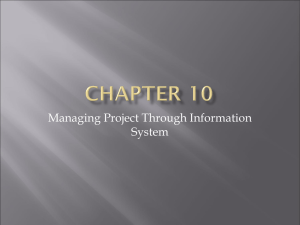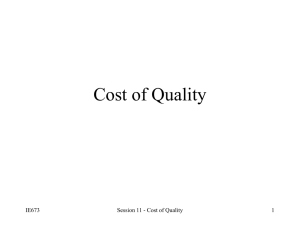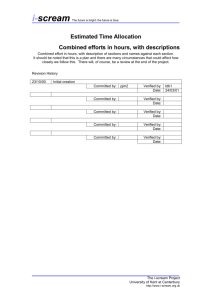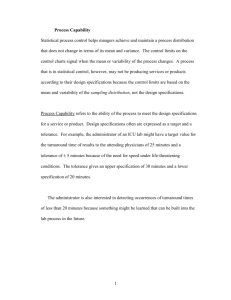NHIN Version and Migration Plan_v3_14April2011
advertisement
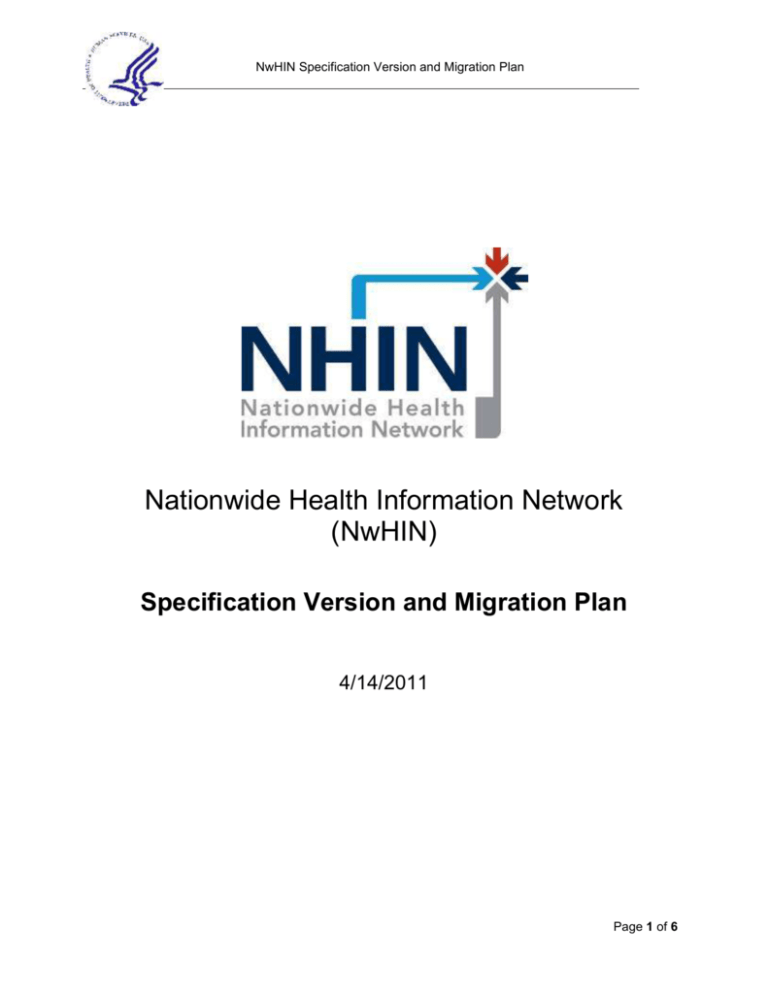
5 NwHIN Specification Version and Migration Plan Nationwide Health Information Network (NwHIN) Specification Version and Migration Plan 4/14/2011 Page 1 of 6 5 NwHIN Specification Version and Migration Plan 1 Executive Summary The current versioning approach for the Nationwide Health Information Network relies upon the ability to discover specific transaction versions in the Web Services Registry (UDDI). NwHIN participants are required to upgrade to latest version of an approved specification in a specified timeframe (3-6 months, depending on a determination of ‘materiality’). Furthermore, the current approach does not address how the NwHIN should handle changes to specifications (Messaging Platform, Authorization Framework and Web Services Registry, etc.). Additionally, when a new version of a specification is developed, it has to go through a materiality review by the NCC. The results of a materiality review can delay the approval process for updated specifications (beyond 6 months). The lock-step upgrade to the new specifications can place a burden on NwHIN on-boarding personnel, as ALL of the NWHIN participants attempt to seek certification under the new specifications within the allotted period. The lock-step upgrade path does not address the situation where an NwHIN participants cannot upgrade in the timeframe allotted (3-6 months) due to business resource constraints (funds, labor, other priorities, etc.). Once an implementation is up and running it is difficult to make the business case to expend resources to upgrade to a new version of a specification. There is currently no process or plan in place to manage an upgrade to a new NwHIN specification version that causes a breaking change while maintaining backwards compatibility and production operational continuity for interoperability. Additionally, maintenance of NwHIN specifications are on individual specification basis and are not managed in a broader context. There is no universal method to communicate exactly which arrangement of specifications is required for implementers to support. The purpose of this document is to define the migration plan for implementers to new versions of NwHIN specifications. The proposed versioning and migration plan are as follows: o o o Facilitate the versioning of specifications within the organizing principle of particular core specifications within the NwHIN community, without requiring NwHIN participants to adopt new specifications in a blanket fashion across the entire NwHIN community. If changes occur in core specifications, the NwHIN governing body will set the transition and deprecation period for the core specification(s) as well as any non-core specification(s) that uses the core specification(s) If changes occur in non-core specifications, the NwHIN governing body will NOT set a transition period for the respective specification(s). The plan will not attempt to dictate or influence implementer’s internal software development lifecycles in terms of adopting these non-core specifications. Rather, implementer’s decision to adopt new specification versions will be driven by their use case (or profile) needs. This approach will address the lack of a migration plan for both minor and breaking changes to specifications while gaining support from the NWHIN community because of its flexibility to implementers. Page 2 of 6 5 NwHIN Specification Version and Migration Plan 2 Proposed Approach 2.1 Assumptions All Trial Implementations participants supported a common version of NwHIN core services, which included transport, security, and other services, for demonstration and production pilot purposes The core specifications are not profile driven, rather the profiles will be driven by the core specifications (see Table 1 for list of core specifications) Web Services Registry is considered a foundational specification to be implemented on the NHIN network in order to exchange interoperable health information over the Internet Support for an update to a Core Spec will be mandatory for all NwHIN Implementers All profiles supporting the core specifications will adopt the latest version of the core specifications The decision to adopt non-core specifications will be internal to the NwHIN Implementation Community and the use cases they support A registry will be created that will allow the ability to capture and track what versions of the non-core specifications (see Table 1 for list of non-core specifications) implementers are supporting A new Spec Factory initiative would not require NwHIN governing body approval to enter the development process, rather consensus by Spec Factory/Implementers community members will be considered as an approval of new specification initiatives The NWHIN Governance body will review the Spec Factory’s final product from a technology and policy perspective Specification releases will occur twice a year, one major release and one minor release as necessary A ‘Major’ release may contain a breaking change A ‘Minor’ release will not contain a breaking change If migration to new core specification version overlaps with next release cycle, the release will be pushed off until the end of the migration period On boarding process WILL ensure compliance to new specification version There will only be one version of specifications (core and non-core) maintained for adoption by implementers A new participant will be required to support current versions of core specifications and relevant non-core specifications The spec factory will not support corrections to previous specification versions. All corrections will be made to current approved versions of the specification Table 1 - NwHIN Specifications NwHIN Specification Category Access Consent Policy Non-core specification Administrative Distribution specification Non-core specification Authorization Framework Core specification Continuity Assessment Record and Evaluation (C.A.R.E.) Profile Document Submission Non-core specification Page 3 of 6 5 NwHIN Specification Version and Migration Plan NwHIN Specification Category Electronic Submission of Medical Documentation (esMD) X12 Profile Electronic Submission of Medical Documentation (esMD) XDR Profile Geocoded Interoperable Population Summary Exchange (GIPSE) Profile Health Information Event Messaging (HIEM) Service Interface Non-core specification Medicaid Eligibility Verification Profile Messaging Platform Core specification Patient Discovery Non-core specification Physician Quality Reporting Initiative (PQRI) Profile Query for Documents Non-core specification Retrieve Documents Non-core specification Web Services Registry Foundational specification 2.2 Approach Overview The proposed approached outlined below, will address the lack of a migration plan for both minor and breaking changes to specifications while gaining support from the NwHIN community because of its flexibility to implementers. The plan proposes a multi-tiered approach for versioning NwHIN Exchange technical requirements. Proposed changes to NwHIN specifications or request to create new specifications will be driven by the following factors: New/improved technology New policy or regulation emerging standard (improvement in best practices) Error in existing specifications The proposed approach will have two major scenarios as outlined in Figure 1 below. Similar to the Direct Project, the Spec Factory Workgroup will accept proposal to change existing NwHIN specifications or request to create new specifications based on group consensus. If approved, a Spec Factory domain workgroup will modify or create the respective specification. An NwHIN governance body will review and approve the newly created or update specification. Additionally, an NwHIN governance body will also develop an implementation and migration plan for core as well as non-core specifications that uses the core specification. The NwHIN governance body will also set the deprecation plan for previous specification versions for core and non-core specifications that uses the core specification. Upon approval and publication of the core specifications by the NwHIN governance body, all NwHIN implementers will be required to implement the newly created or updated Page 4 of 6 5 NwHIN Specification Version and Migration Plan version of the core and non-core specifications by the timeframe set by the NwHIN governance body. However, for changes to non-core specification, NwHIN implementers will have the option to adopt and implement non-core specifications based on their internal organizational use case needs. Changes to Core Specifications Changes to NonCore Specifications •Changes to core specs triggers changes to all non-core specs and profiles that uses the core spec •NwHIN governing body will set the transition and deprecation period for core and non-core spec based on severity of breaking changes and survey of implementers •All implementers will be required to migrate to the new spec version (core and noncore) as well as update profiles •Changes to non-core specs will NOT require changes to profiles using such specs •NwHIN governing body will NOT set the transition or deprecation period •Implementers will NOT be required to adopt changes to non-core spec, rather they will determine the need to support new non-core spec version Figure 1 - Proposed Plan for Version Migration 2.2.1 Core Transport Specifications There should be a unified upgrade approach and timeframe for core transport specifications. All NwHIN Exchange Participants should be required to support the same version for transport / security to enable interoperability at the most basic level to assure uniformity across all use cases. Version updates should occur every couple of years (e.g. an approach like that used for HIPAA Transaction and Code Set standards, where there is a period for dual use and a final cutoff date). Near-term Exchange Implications: Coordinated upgrade necessary to migrate production participants to the latest version of the following specifications: - Auth framework - Messaging platform Proposed timeframe: 4 months (9/1/11) Longer-term Implications: To support this approach, the following specifications would need to be cleaned up and modularized in order to support various transport methods, such as SOAP over HTTP, SMTP. 2.2.2 Other Service-Related NwHIN Specifications to Support Exchange Patterns The DURSA requires NwHIN Exchange Participants to support at least one “Exchange Pattern” (e.g. patient discovery/query/retrieve, document submission, publish / subscribe). Page 5 of 6 5 NwHIN Specification Version and Migration Plan The corresponding service-related specifications should not be anchored to any particular profile, but should be available for implementation across a myriad of use cases. However, these specifications should be versioned on an annual basis. Required migration timeframes should be specified in NwHIN Exchange Profiles, as described below. Near-Term Implications: How to address versioning / migration for revised specifications in the absence of having Exchange profiles today? Options: i. Specify a single timeframe for migration across all use case supported (e.g. VLER, SSA, and CDC – pub/sub). ii. Specify different timeframes for migration of existing use cases, if needed. iii. Wait until there are profiles developed to support existing Exchange use cases. Longer-Term Implications: Participants who exchange for multiple use cases may need to support different versions for the same specification. 2.2.3 NwHIN Specification Profiles Profiles define how a community wishes to exchange data using NwHIN service and content specifications to support a particular use case. Communities should have the flexibility to adopt and implement the specifications in a manner most appropriate to serve their business needs. The community should determine how to constrain / implement a specification, including the business purpose, core specifications required, versions of specifications supported. All profiles should be updated to reflect new versions of the core transport specifications (i.e. Auth Framework, Messaging Platform, Web Services registry). The profile could support current or older versions of NwHIN Exchange service and content specifications. o The profile could force an upgrade to a particular version of a new service-related NwHIN specification such as Patient Discovery. Profiles are added to registry to enable NwHIN participants to discover other exchange partners that support those profiles Near-Term Implications: Profiles that may address NwHIN Exchange needs are being developed as part of two S&I initiatives: CDA consolidation and Transfer of Care S&I Initiatives. Approach / process to develop other NwHIN Exchange profiles. Longer-Term Implications: Further discussion needed 2.3 Open Questions What do we do in the case of an emergency scenario such as security breach that may require a “patch” release? Need definition for major vs. minor release and what is mandatory Will on boarding process ensure compliance to migration/transition period? Page 6 of 6
